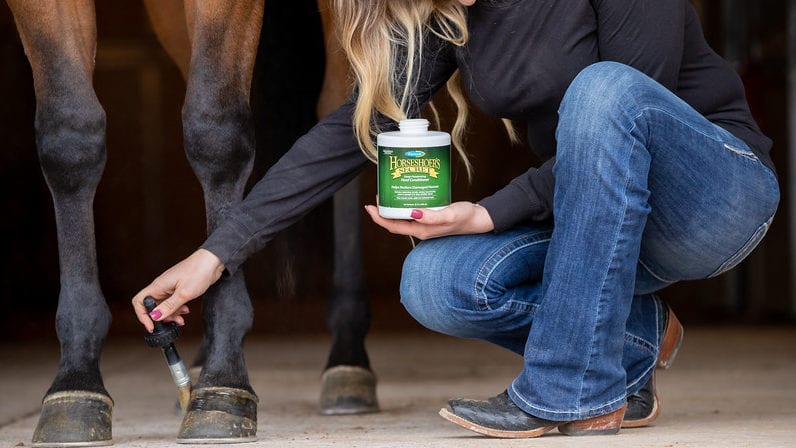Browse the shelves at your local equine supply store, and you’ll find a wealth of topical hoof products. Two popular options are hoof sealants and conditioners.
Do you need one or both? How do you know when to use either product?
Weather, environment, and the current condition of your horse’s hooves all influence which product you use–and when.
Consider Your Horse’s Environment
“Which topical product you use really depends on the horse’s environment,” says Kenneth Brunetti, a farrier with 50 years of experience who specializes in shoeing performance and racehorses. Because Brunetti has worked in both Michigan and Arizona, he has experience in various climates and conditions.
A horse’s hooves will tell you a great deal about where he lives and works and his stabling conditions.
“Horses’ feet tend to mirror their environment,” notes certified journeyman farrier Jason Maki of the College of Veterinary Medicine Teaching Hospital at Texas A&M University.
“In incredibly wet conditions, the hoof can absorb too much moisture and become overly pliable and soft. The sole is more apt to bruise because it’s soft, and the foot is more vulnerable to abscesses and bacteria. The foot appears wider and flatter and tends to flare in the toe because a foot with excessive moisture can’t bear weight without bending,” explains Maki.
“If it’s very dry and the hoof doesn’t have moisture, it will become hard and brittle and have no flexion,” he adds. “The wall will chip and break around the edges in barefoot horses, and even in horses with shoes, the nails can loosen.”
Don’t Forget Nutrition
Balanced nutrition should be the starting point for healthy hooves, no matter where a horse lives.
“A good diet is the first thing I recommend. If the horse is not eating well, it will show in their feet,” says Brunetti.
Besides, he always advises feeding a hoof supplement like Horseshoer’s Secret® Extra Strength Hoof & Connective Tissue Supplement to ensure the horse has all the nutrition needed to support strong hooves.
“A hoof supplement helps the hoof grow from within, which is most important,” says Brunetti, adding that a healthy hoof has elasticity, which helps prevent cracking.
Dry Conditions
“The hoof is more susceptible to cracking in drier climates like in Arizona. When the ground is hard, and the air is dry, I use a hoof conditioner secondary to feeding a hoof supplement most of the year to help with elasticity,” says Brunetti. “Adequate water intake also plays a role,” he adds.
To help ensure your horse is drinking enough water, you may want to add salt or Apple Elite™ Electrolyte to his feed, encouraging water consumption.
“Horses who live or work on sand will most likely need more moisture, as sand will pull moisture out,” says Brunetti. “A hoof conditioner like Horseshoer’s Secret® Deep-Penetrating Hoof Conditioner can help keep the hooves pliable. You want to apply the conditioner all over the hoof, up to the coronary band and the soles and bulb of the heel.”
Wet Conditions
“The hoof is like a sponge; it absorbs the moisture in its environment. When the hoof is too wet or soft, you can see issues developing, as well as loose shoes,” observes Brunetti.
“You want to do your best to keep the hooves dry,” he adds. “You can provide a dry area for your horse, such as dry shavings or a clean stall. Check your horse’s hooves regularly for loose nails or signs of infection. If needed, a topical product such as Horseshoer’s Secret® Hoof Sealant can help keep the moisture out.”
A sealant helps provide a barrier against excess moisture entering the hoof. A sealant can be applied to the hoof wall weekly or as needed.
The hooves must be clean and dry before applying sealant. Begin approximately a half-inch below the coronary band and continue applying down the hoof wall. Allow drying between additional coats, if required. Don’t apply sealant on the coronary band or bulbs of heels.
Maki adds that if your farrier can “hot fit” the shoes for shod horses, this is beneficial during wet seasons and conditions.
Even for horses living in humid climates, hooves can dry during warm months, so that a hoof conditioner may be necessary for a period of time.
Barefoot vs. Shod
Whether a horse is barefoot or shod doesn’t dictate whether you use a hoof conditioner or sealant.
“I would recommend the same thing for a barefoot horse or a shod horse. It really depends on the horse and his hooves,” says Brunetti.
“If a horse has fairly good genetics, a good diet, and an ideal climate, their feet will be easier to maintain whether they are barefoot or shod. It also depends on how often the horse is being ridden. Some horses have stronger feet and can withstand more barefoot.”
Whether your horse is barefoot or shod, Maki emphasizes the importance of sticking to a regular trimming or shoeing cycle appropriate for the individual horse.
“I have found that in general, with good maintenance and a good hoof care cycle, hooves tend to stay in pretty good shape,” he says.
Improve the Environment
And no, we’re not talking about climate change, but rather making improvements to your horse’s immediate environment.
“The optimal hoof environment has an equilibrium–not too dry or too wet,” says Maki.
He adds that horses living in extremely dry, sandy areas need a way to add moisture to the hoof. In addition to using a hoof conditioner, it may help just slightly to overflow the water tank, so the horse stands in a damp area (not mud!) for a few minutes when drinking.
“In a damp, humid, muddy environment, horses need a dry place to stand for a good part of the day, whether that’s a stall with good dry shavings or a dry lot with a covered area,” he notes.
In turn-out areas or run-in sheds, you can avoid mud by improving the footing with sand, crushed rock, or mud grids. A slight slope (2 to 5 percent) will allow rain to run off.
Rugged geotextile fabric and layers of rock can prevent high traffic from becoming muddy and destroying the surrounding ground and grass. Your local county extension office can provide plans or recommendations for building a high traffic pad to reduce mud around feeders, waterers, and gates.
Consider fencing off consistently wet or boggy places in pastures to keep horses out of these areas.
In addition to making improvements to your horse’s physical environment, use the appropriate topical product–either hoof sealant or hoof conditioner–as needed throughout the year.
CLICK HERE for more information from Farnam.








